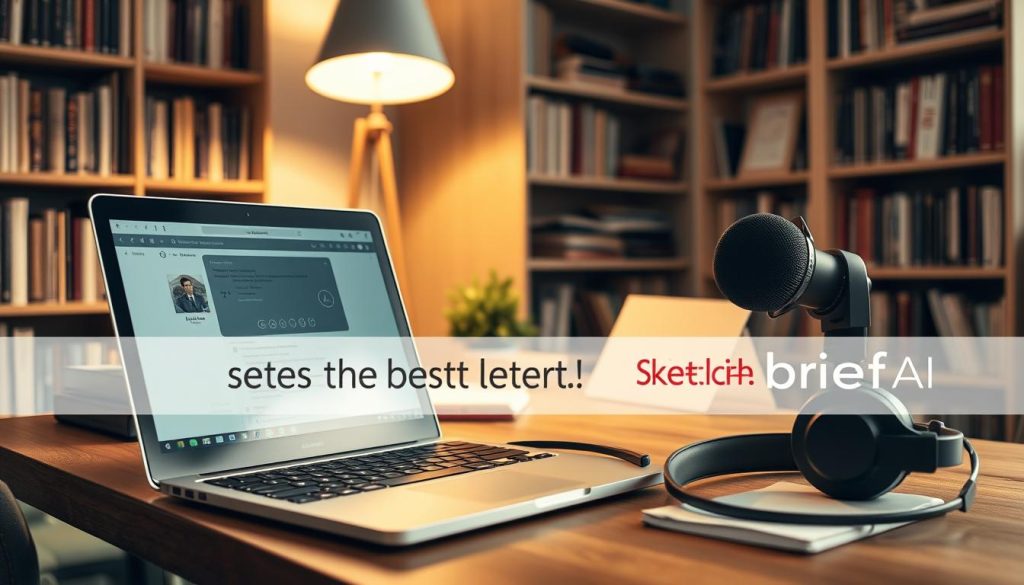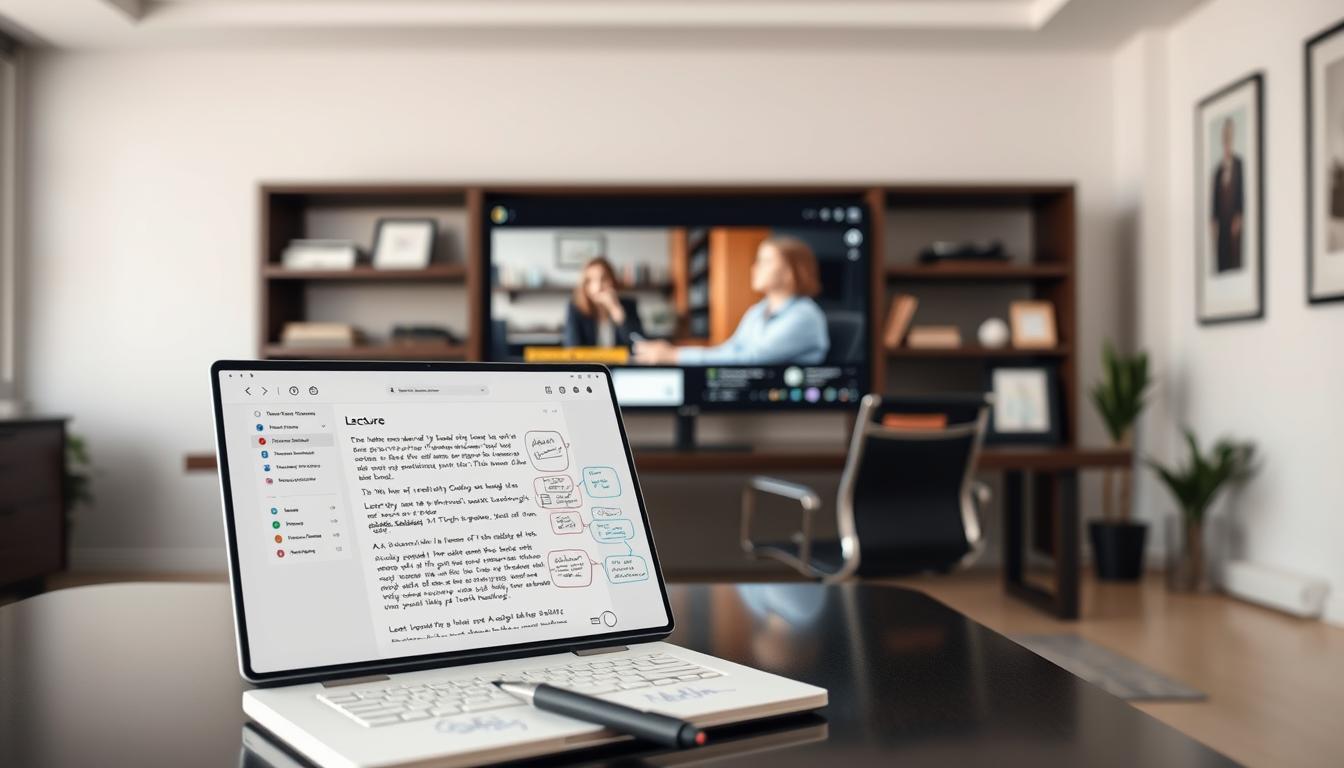Can software really free you to listen and learn without losing a single key point? We think so—and we’ll show how today’s tools change study habits and boost retention.
In 2025, powerful platforms can record lectures, transcribe audio and video, and turn raw content into study-ready summaries. That saves hours of manual work and creates a searchable archive you can revisit.
We outline the best options—from lightweight choices that capture and sync audio to robust systems that identify speakers, translate in real time, and generate flashcards and quizzes. You’ll learn when to use a simple recorder versus a full-featured taker that produces outlines and summaries.
Our review highlights ScreenApp, Otter.ai, Notta, Notability, Tactiq, Supernotes, Fathom, Knowt, and Coconote. We explain how each tool handles transcription, sync, and study outputs so you can pick what fits your classes and schedule.
Key Takeaways
- Modern tools let you record lectures and get fast, accurate transcription.
- Choose simple recorders for quick capture; pick fuller platforms for translation and outlines.
- Study-ready outputs—summaries, flashcards, quizzes—save time and improve recall.
- Look for cross-device sync, import support for video/audio, and speaker ID when needed.
- We map each tool to common student workflows so you can match features to budget.
Why automated note taking apps for lectures matter right now
Today’s systems make it easy to stop sprint-typing and start listening with intent. Clear, near-instant capture turns spoken content into searchable text so you can focus on concepts instead of capturing every word.
The 2025 leap: real-time recording, transcripts, and AI summaries
Transcription now routinely reaches 95%+ accuracy with clean audio. Leading platforms handle accents and let you add technical vocabulary to boost precision.
Speed and structure matter: live transcripts, short summaries, and outlines appear in seconds. That processing cuts the delay between class and review, and creates a reliable archive you can search.
From frantic typing to focused learning: solving the lecture dilemma
By converting speech to text quickly, you regain class time for asking questions and engaging your teacher. Short, linked summaries let you verify any passage against the original audio.
These tools reduce cognitive load, improve recall, and scale across many sessions so your study workflow gets faster and more consistent. Remember to check recording permissions and respect privacy before saving class material.
How we chose the best tools for students and lecture-heavy classes
We screened each platform against real student workflows to find tools that keep pace with fast classrooms. Our goal was practical: recommend options that save time and deliver reliable study outputs.
Transcription accuracy and speed in live classes
We prioritized transcription accuracy and low latency. Slow or error-prone transcripts break concentration and harm recall.
Language support and speaker identification
We measured language coverage and speaker ID. Notta’s wide language range and Otter.ai’s speaker tagging stood out in multilingual courses.
Study-centric features and device reach
We scored platforms on summaries, flashcards, and quizzes. Knowt and Coconote convert uploads—audio, videos, and documents—into study-ready outputs.
Exports, sync, and pricing
We checked device compatibility, cloud sync, export formats, and free-plan limits. ScreenApp offered one-click recording and generous free minutes. Notability pairs audio with handwritten or typed notes.
- Real-time accuracy and latency
- Language and speaker flexibility
- Study outputs and data portability
- Budget-friendly free tiers and collaboration
| Criterion | Key Metric | Standout | Why it matters |
|---|---|---|---|
| Transcription | Accuracy & speed | Otter.ai, ScreenApp | Fast, reliable text helps you review quickly |
| Language & ID | Language count & speaker tags | Notta, Otter.ai | Works in multilingual classes and multi-instructor courses |
| Study features | Summaries, flashcards, quizzes | Knowt, Coconote | Turns transcripts into active learning materials |
| Export & pricing | Formats, minute caps, sync | ScreenApp, Notability | Keeps documents portable and fits student budgets |
The top picks at a glance: best apps to record lectures and take notes
Here are the tools that best bridge classroom capture and study-ready text.
We tested clarity, speed, and export options and highlighted which platforms match common student workflows. Each pick solves a different problem—from quick capture to strong organization and language support.

Best for simplicity and generous free plan: ScreenApp
Why choose it: one-click browser screen and audio recording, fast AI transcription, search/edit/export, and a generous free tier that suits casual users.
Best for real-time collaboration and outlines: Otter.ai
Why choose it: live transcription with speaker ID, automated outlines, and Zoom/Meet integration. Free tier starts at 300 minutes; paid tiers scale to heavy use.
Best for multilingual classes: Notta
Why choose it: real-time transcription in 104 languages, translations, and automated summaries—handy in immersion courses.
Best for manual note-takers with audio sync: Notability
Why choose it: records audio while you handwrite or type, then syncs playback to each written passage. Strong organization and a one-time purchase model.
Also great
- Tactiq — live translation layered on captions.
- Supernotes — powerful organization and cards.
- Fathom — concise meeting-style summaries.
| Platform | Standout | Free tier | Best use |
|---|---|---|---|
| ScreenApp | One-click recording, search | Generous minutes | Quick capture & clean transcripts |
| Otter.ai | Live transcription, outlines | 300 min free | Collaborative classrooms |
| Notta | 104 languages, translation | Generous free plan | Multilingual courses |
| Notability | Audio-sync with handwriting | Paid one-time | Manual notetakers who need sync |
If you have questions about fit, check integrations (Zoom/Meet, browser), minute caps, and export formats. Pick a capture-first tool or a study-first taker based on your course load and study habits.
Deep dive: which automated note taking app for lectures fits your needs?
Your workflow — continuous recording, selective highlights, or hybrid capture — tells you which tool will save the most time. Below we break options into clear strengths so you can map features to how you study.
Quick picks and what each does best
- ScreenApp — one-click screen and audio record, fast AI transcripts, search/edit/export for quick review.
- Otter.ai — live transcription with speaker ID, Automated Outline, and Zoom/Meet integration for team work.
- Notta — 104 languages, translation, and summaries that speed cross-language study sessions.
- Notability — handwriting or typed notes synced to audio; playback links notes to recorded moments.
- Tactiq, Supernotes, Fathom — caption translation, hierarchical organization, and meeting-style summaries, respectively.
| Platform | Standout | Best use |
|---|---|---|
| ScreenApp | Fast transcripts, export | Quick capture & review |
| Otter.ai | Speaker ID, outlines | Group study & long sessions |
| Notta | Language & translations | Multilingual courses |
| Notability | Audio sync with handwriting | Detailed note builders |
Tip: if you need flashcards or spaced-repetition, pick a tool that converts transcripts to study assets natively. That saves export time and keeps review in one place.
Student-focused standouts: Knowt and Coconote for study-ready notes
Good study tools change transcripts from passive text into active practice in minutes.
Knowt — records live sessions and builds flashcards and quizzes
Knowt records live sessions or accepts uploads and converts content into editable notes, flashcards, and quizzes.
You can keep the original recording to check teacher phrasing and choose outline or paragraph formats. Flashcards and quiz sets are generated to support spaced practice and exam prep.
Coconote — ingest links, audio, videos, documents and YouTube videos
Coconote accepts links, audio, videos, documents, websites, and YouTube videos and returns organized notes and transcripts in seconds.
Its AI chat lets you ask targeted questions about your materials. Coconote also produces practice exams, podcasts, and flashcards to vary study practice across devices.
Why study tools matter
Both platforms shrink the gap between capture and active review.
- Automatic flashcards and quizzes speed rehearsal.
- Cross-device sync and mobile support make study on the go simple.
- Design choices help students with ADHD and different learning needs.
| Feature | Knowt | Coconote |
|---|---|---|
| Input types | Live recording, uploads | Links, audio, videos, documents, YouTube |
| Outputs | Editable notes, flashcards, quizzes | Notes, transcripts, flashcards, practice exams |
| Speed | Fast processing | Organized in seconds |
| Mobile | Web & mobile access | iOS & Android, sync |
Real-world use cases: classes, study groups, and beyond
Practical use shows how recording and quick transcripts change what students do after class. Capture turns long sessions into bite-sized study assets you can reuse across subjects.

Recording live lectures and reviewing transcripts after class
In large classes we recommend you record live, then scan transcripts to revisit tricky segments. That saves time—no full rewatch of long videos. You can jump to exact moments and capture citations quickly.
Study groups and shared notes with real-time collaboration
Study groups share highlights, assign sections, and merge edits into one study packet. Otter.ai and ScreenApp speed capture and collaboration. Notta helps when classmates use different languages.
Support for ADHD and auditory processing with structured summaries
Students report gains using Coconote to create structured summaries and flashcards. Clear, linked summaries present key points and point back to the original recording for context.
Webinars, conferences, and meetings as searchable study content
Record webinars and conferences to build a searchable archive. Convert meeting audio into transcripts and flashcards to prep for exams or projects.
- Agree on etiquette and confirm with your professor before recording class sessions.
- Upload YouTube videos from assigned material to keep references in one place.
- Name files consistently so your archive scales across terms.
Set up for success: getting high-quality lecture recordings
Small recording habits yield big gains—clear sound, consent, and custom vocabulary.
Audio basics: place the mic close to the speaker and set input levels so peaks don’t clip. Choose a seat away from doors and HVAC. Use a directional mic when possible to cut ambient noise.
Test a 10–20 second sample before class. Confirm the waveform looks healthy and play it back. Good capture boosts AI accuracy; with clean input, transcription often exceeds 95%.
Get permission, be transparent
Clarify intent with your professor and teacher. Explain how you’ll store files and how long you’ll keep them. Many schools require consent or signage before recording class or guest talks.
Boost accuracy with subject vocab
Add domain terms, abbreviations, and rare names to custom vocabularies. Accuracy drops with background noise, accents, or heavy jargon, but models improve as you correct transcripts and feed subject-specific terms.
- Prefer direct feeds for hybrid sessions—source audio beats laptop mics.
- Enable speaker ID when multiple voices matter.
- Pick tools known for fast processing so summaries appear in seconds.
Choosing the right lecture note taker for your class load
Match your study load to a tool that handles the mix of languages, diagrams, and dense formulas in your syllabus.
Start by listing course needs: language support, heavy diagrams or equations, and how many hours you will record each month.
Match features to courses: languages, diagrams, STEM terminology
Pick a tool that recognizes subject-specific terms and can export clean documents that keep diagrams and equations intact.
STEM classes often require math rendering and image-friendly exports. Humanities classes value translation and text search.
If you work in multiple languages, prioritize tools with wide language support and accurate speaker separation.
Free vs paid tiers: minute limits, export needs, and mobile access
Map free-plan limits to your schedule. Otter.ai gives 300 monthly minutes; Notta offers about five free hours. ScreenApp includes a generous free tier, while Notability uses a one-time purchase model.
Check export formats—PDF, SRT, and editable documents matter when you annotate slides or build flashcards.
- Start with your syllabus and align tools to subjects and term load.
- Verify mobile listings in your preferred store so you can study on the go.
- Test free tiers; upgrade when time saved exceeds subscription cost.
- Prioritize shared editing and speaker tags if classmates collaborate.
- Confirm support channels and response times before relying on recordings for labs.
Conclusion
Your study routine improves fastest when capture fits your habits, not the other way around.
We recommend starting with one clear choice: ScreenApp for speed, Otter.ai for collaboration, Notta for language depth, Notability for synced handwriting, and Knowt or Coconote to produce flashcards and quizzes that speed exam prep.
Pick a tool that helps you take notes without splitting attention during a lecture. Try free tiers, track how much time you save, then upgrade when the ROI is obvious.
Keep files tidy: consistent names, clear folders, and synced copies in the official store accounts so review is fast and reliable across devices.

Leave a Reply